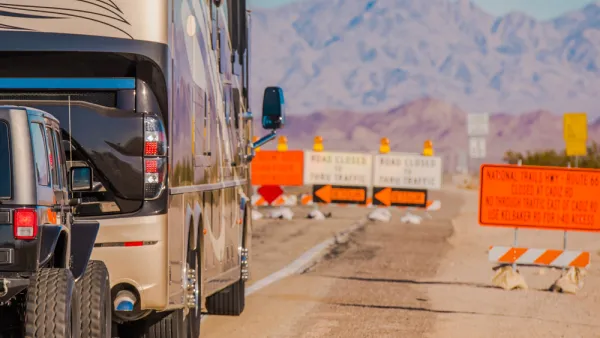The $900 billion COVID relief bill along with a $1.4 trillion omnibus bill allowed for the inclusion of unrelated legislation and funding for 2021, from border wall spending to phasing-out some of the most potent greenhouse gas pollutants.

On Monday night, Congress approved one of the largest spending bills in its history, the $2.3 billion Consolidated Appropriations Act of 2021 (H.R. 133) which included the $900 billion coronavirus relief bill (see "related" Planetizen posts below).
The larger part of the spending package is "a $1.4 trillion omnibus bill based on a 2019 spending deal, which consists of $740.5 billion in defense spending and $664.5 billion for domestic programs," writes Niv Elis for The Hill (source article).
While the COVID-19 relief bill focuses on extending unemployment, providing stimulus checks and boosting small businesses, the omnibus includes a broader set of policy issues, such as transportation, agriculture, health, homeland security and foreign operations.
The omnibus also included $1.375 billion for 56 miles of President Trump’s border wall, an issue that has become a central obstacle in passing spending legislation during his presidency.
Ellis adds that the omnibus includes "energy legislation that would restrict the use of hydrofluorocarbons (HFCs), a greenhouse gas common in air conditioners. It is the first significant piece of climate legislation in over a decade."
The phase-down of the production of HFC's was one of three provisions included in bipartisan environmental innovation legislation that was passed by the Senate Committee on Environment and Public Works (EPW).
“Republicans and Democrats are working together to protect the environment through innovation,” said the chairman, Sen. John Barrasso, R-Wyo, reported Matthew Daly for the Associated Press on the energy and climate provisions in the omnibus part of H.R. 133.
“This is the most significant greenhouse gas reduction bill to ever pass Congress and it won’t raise costs for American families," Barrasso stated in the committee's press release on Tuesday that describes the three environmental components of the legislation:
- "The Utilizing Significant Emissions with Innovative Technologies (USE IT) Act to promote carbon capture technologies;
- "The reauthorization of the Diesel Emissions Reduction Act (DERA) program; and
- "The American Manufacturing and Innovation (AIM) Act, which would implement a 15-year phasedown of hydrofluorocarbons (HFCs) at a national level for the first time, administered by Environmental Protection Agency (EPA)."
In addition, the omnibus also included "$35 billion in spending on wind, solar and other clean power sources," reports Coral Davenport for The New York Times.
They amount to a rare party rebuke to Mr. Trump on the issue of global warming, after he spent the past four years mocking and systematically rolling back every major climate change rule. The comity may also signal that while President-elect Joseph R. Biden Jr. is unlikely to secure his full climate plan, he may be able to make some progress in curbing global warming.
"How did this remarkable triumph come about?" asks Jonathan Chait of New York Magazine.
The larger lesson here is that, in the modern era, constructive legislation is still possible — as long as the issue stays below the radar.
If these climate provisions had not been thrown into a coronavirus-relief bill and Joe Biden had tried to pass the exact same policies two months from now, right-wing media would be aflame with denunciations of his “Green New Deal.”
But wait! H.R. 133 still has to be signed by President Trump. Elis reports on Tuesday night that Trump has blasted the historic spending bill, so stay tuned.
Hat tips to Jim Stewart and David McCoard.
Related in Planetizen:
- COVID Stimulus Details for Planners, December 22, 2020
- What's in the New Economic Stimulus Package for U.S. Transit Agencies, December 17, 2020
-
Bipartisan Support for Federal Diesel Emissions Reduction Bill, March 23, 2019
FULL STORY: Congress unveils $2.3 trillion government spending and virus relief package

Analysis: Cybertruck Fatality Rate Far Exceeds That of Ford Pinto
The Tesla Cybertruck was recalled seven times last year.

National Parks Layoffs Will Cause Communities to Lose Billions
Thousands of essential park workers were laid off this week, just before the busy spring break season.

Retro-silient?: America’s First “Eco-burb,” The Woodlands Turns 50
A master-planned community north of Houston offers lessons on green infrastructure and resilient design, but falls short of its founder’s lofty affordability and walkability goals.

Test News Post 1
This is a summary

Analysis: Cybertruck Fatality Rate Far Exceeds That of Ford Pinto
The Tesla Cybertruck was recalled seven times last year.

Test News Headline 46
Test for the image on the front page.
Urban Design for Planners 1: Software Tools
This six-course series explores essential urban design concepts using open source software and equips planners with the tools they need to participate fully in the urban design process.
Planning for Universal Design
Learn the tools for implementing Universal Design in planning regulations.
EMC Planning Group, Inc.
Planetizen
Planetizen
Mpact (formerly Rail~Volution)
Great Falls Development Authority, Inc.
HUDs Office of Policy Development and Research
NYU Wagner Graduate School of Public Service




























